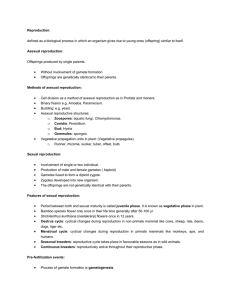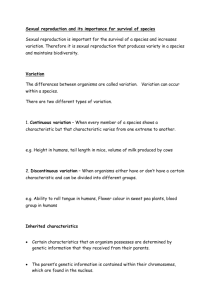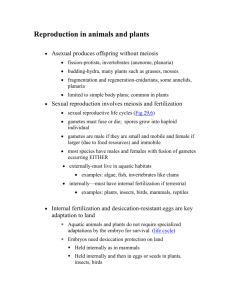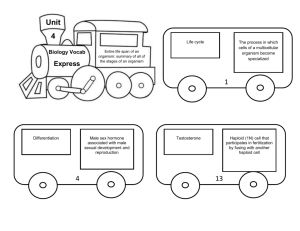REPRODUCTION IN ORGANISMS Reproduction: defined as a
advertisement
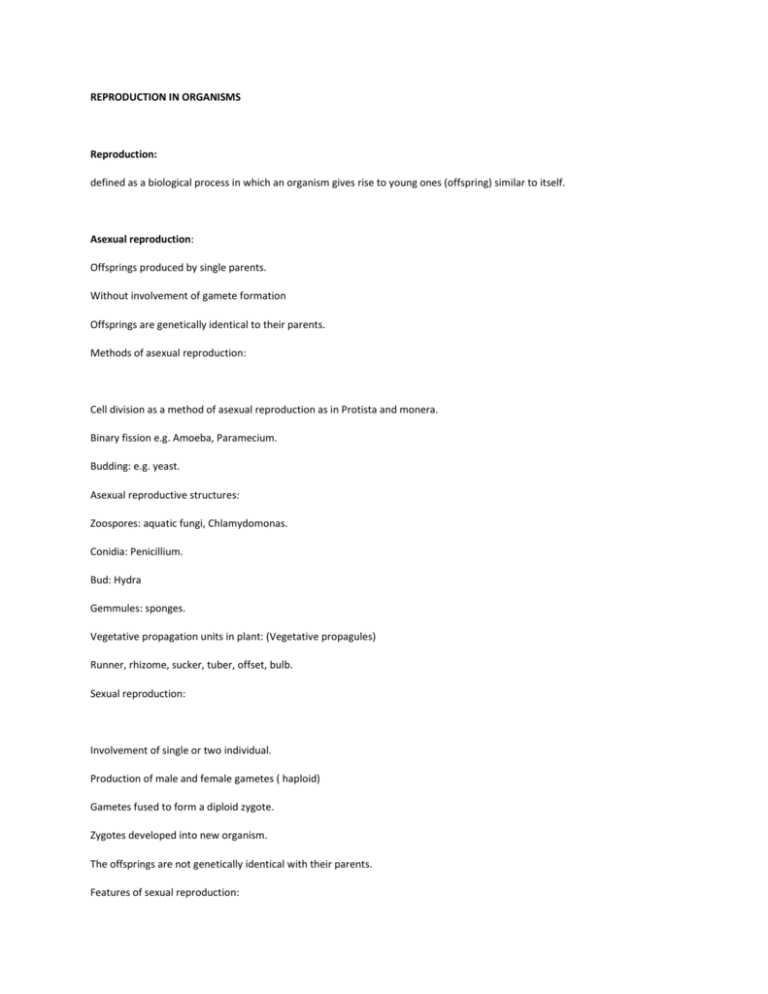
REPRODUCTION IN ORGANISMS Reproduction: defined as a biological process in which an organism gives rise to young ones (offspring) similar to itself. Asexual reproduction: Offsprings produced by single parents. Without involvement of gamete formation Offsprings are genetically identical to their parents. Methods of asexual reproduction: Cell division as a method of asexual reproduction as in Protista and monera. Binary fission e.g. Amoeba, Paramecium. Budding: e.g. yeast. Asexual reproductive structures: Zoospores: aquatic fungi, Chlamydomonas. Conidia: Penicillium. Bud: Hydra Gemmules: sponges. Vegetative propagation units in plant: (Vegetative propagules) Runner, rhizome, sucker, tuber, offset, bulb. Sexual reproduction: Involvement of single or two individual. Production of male and female gametes ( haploid) Gametes fused to form a diploid zygote. Zygotes developed into new organism. The offsprings are not genetically identical with their parents. Features of sexual reproduction: Period between birth and sexual maturity is called juvenile phase. It is known as vegetative phase in plant. Bamboo species flower only once in their life time generally after 50-100 yr. Strobilanthus kunthiana (neelakranji) flowers once in 12 years. Oestrus cycle: cyclical changes during reproduction in non-primate mammal like cows, sheep, rats, deers, dogs, tiger etc. Menstrual cycle: cyclical changes during reproduction in primate mammals like monkeys, ape, and humans. Seasonal breeders: reproductive cycle takes place in favourable seasons as in wild animals. Continuous breeders: reproductively active throughout their reproductive phase. Pre-fertilization events: Process of gamete formation is gametogenesis. Two gametes are similar in appearance are called homogametes (isogametes). Gametes produced are of two morphologically distinct types called heterogametes. Male gamete is called antherozoids or sperm and the female gamete is called ovum or egg. Sexuality in organism: Plant having both male and female sex organ called homothallic or monoecious. Plants having only one sex organ is called heterothallic or dioecious. In flowering plants, the unisexual male flower is staminate, i.e. bearing staments, while the female is pistillate or bearing pistils. Animal having one type of reproductive system, called unisexual. Animal having both male and female reproductive system, called hermaphrodite or bisexual. Cell division during gamete formation: Gametes in all heterogametic species two types namely male and female. Gametes are always haploid irrespective of parent’s ploidy. A haploid parent produces gametes by mitotic division. Diploid parent produces gametes by meiotic division. In diploid organisms specialized cells called meiocytes (gamete mother cell) undergo meiosis to produce haploid gametes. Gamete transfer: Male and female gamete must be physically brought together to facilitate fusion called fertilization. In most cases male gametes are motile, female gametes are non-motile. In case of few fungi and algae, both male and female gametes are motile. In most cases water is the medium for gamete transfer. Male gametes are produced in several thousand times the number of female gametes produced to compensate the loss during transfer. Fertilization: Fusion of male and female gamete is called fertilization or syngamy. The female gamete undergoes development to form new organism without fertilization. This phenomenon is called parthenogenesis. Gametic fusion takes place outside the body i.e. water is called external fertilization. Their must be synchrony of gamete release, large number of gametes released to enhance the chance of fertilization. Enable the individual to produce large number of offsprings. A major disadvantage is that the offsprings are extremely vulnerable to predators. Fertilization takes place inside the body is called internal fertilization. Zygote: Formation of zygote after fertilization is universal in all sexually reproducing organisms. Zygote is formed usually in water in case of external fertilization. Zygote is formed inside the body of the organism in internal fertilization. Zygote of fungi and algae develops a thick wall that is resistant to dessication and damage. Organism with haplontic life cycle, zygote undergoes meiosis to produce haploid spores. Embryogenesis: Development of zygote into an embryo is called embryogenesis. Zygote undergoes cell division (mitosis) and cell differentiation. Oviparous animal which lays eggs and development takes place inside egg. Viviparous animal gives birth to the young. The development takes place inside the body of the female. In plants: Zygote developed into embryo. Ovule developed into seed Integument of the ovule developed into seed coat. Ovary developed into fruit. Ovary wall developed into pericarp.


